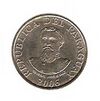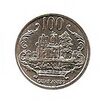Finance:Paraguayan guaraní
| Guaraní paraguayo (Spanish) | |
|---|---|
| ISO 4217 | |
| Code | PYG (numeric: 600) |
| Unit | |
| Unit | guaraní |
| Plural | guaraníes |
| Symbol | ₲ or Gs. |
| Denominations | |
| Subunit | |
| 1⁄100 | céntimo (¢) because of inflation, céntimos are no longer in use. |
| Banknotes | ₲2,000, ₲5,000, ₲10,000, ₲20,000, ₲50,000, ₲100,000 |
| Coins | ₲50, ₲100, ₲500, ₲1,000 |
| Demographics | |
| User(s) | |
| Issuance | |
| Central bank | Banco Central del Paraguay |
| Website | www |
| Printer | De La Rue Giesecke & Devrient Polska Wytwórnia Papierów Wartościowych (pl) |
| Website | De La Rue Giesecke & Devrient Polska Wytwórnia Papierów Wartościowych |
| Mint | Banco Central del Paraguay[citation needed] |
| Website | www |
| Valuation | |
| Inflation | 2% |
| Source | [1], November 2009 est. |
The currency sign is U+20B2 ₲ GUARANI SIGN (HTML ₲); if unavailable, "Gs." is used.
History
The law creating the guaraní was passed on 5 October 1943, and replaced the peso fuerte at a rate of ₲1 = 100 pesos fuertes. Guaraníes were first issued in 1944. Between 1960 and 1985, the guaraní was pegged to the United States dollar at ₲126 = US$1.[citation needed]
Coins
In 1944, aluminum-bronze coins were introduced in denominations of 1¢, 5¢, 10¢, 25¢ and 50¢. All were round shaped. The obverses featured a flower with "Republica del Paraguay" and the date surrounding it, except for the 50¢, which featured the lion and Liberty cap insignia. The denomination was shown on the reverses.[citation needed]
First series:[1]
| Value | Obverse | Reverse | First issued |
|---|---|---|---|
| 1¢ | Flower of the common guava, Psidium guajava | Denomination and wreath | 1944 |
| 5¢ | Flower of Passiflora edullis | Denomination and wreath | 1944 |
| 25¢ | An orange blossom, the fragrant flower of Citrus sinensis | Denomination and wreath | 1944 |
| 50¢ | Flower of the Lapacho tree, Handroanthus impetiginosus, the national tree of Paraguay | Denomination and wreath | 1944 |
The second issue, introduced in 1953, consisted of 10¢, 15¢, 25¢ and 50¢ coins. All were again minted in aluminium-bronze but were scallop shaped and featured the lion and Liberty cap on the obverse. Céntimo coins ceased to be legal tender in 1966, leaving Paraguay without any circulating coins for its currency.[citation needed]
In 1975, coins were introduced in denominations of ₲1, ₲5, ₲10 and ₲50, all of which were round and made of stainless steel. Since 1990, stainless steel has been replaced by brass-plated steel nickel-brass. ₲100 coins were introduced in 1990, followed by ₲500 in 1997. ₲1,000 coins were minted in 2006 and released in 2007.[citation needed]
Coins in denominations of ₲1, ₲5 and ₲10 and coins of ₲50, ₲100 and ₲500 guaranies minted until 2005 lost their legal tender status on 8 January 2014.[2]
| Value | Obverse | Reverse | Diameter (mm) | Weight (g) | First issued | Obverse Image | Reverse Image |
|---|---|---|---|---|---|---|---|
| ₲50 | Marshal José Félix Estigarribia | Acaray Dam | 19 | 1 | 1975 | ||
| ₲100 | General José Eduvigis Díaz | Ruins of Humaitá | 21 | 3.73 | 1990 | 
|

|
| ₲500 | General Bernardino Caballero | Central Bank of Paraguay | 23 | 4.75 | 1997 | ||
| ₲1,000 | Marshal Francisco Solano López | National Pantheon of the Heroes | 25 | 6 | 2006 |
Banknotes
The first guaraní notes were of 50¢, ₲1, ₲5, and ₲10 overstamped on $P50, $P100, $P500, and $P1,000 in 1943. Regular guaraní notes for ₲1, ₲5, ₲10, ₲50, ₲100, ₲500 and ₲1,000, soon followed. They were printed by De La Rue.
The 1963 series (under the law of 1952) was a complete redesign. The lineup also expanded upward with the addition of ₲5,000 and ₲10,000. The 1982 revision added denominations in the Guaraní language to the reverses.
The first ₲50,000 notes were issued in 1990, followed by ₲100,000 in 1998.
Starting from 2004, the existing denominations, except ₲50,000, underwent small but easily noticeable changes, such as a more sophisticated and borderless underprint and enhanced security features. Giesecke & Devrient print the new ₲20,000 note, while De La Rue prints the rest. In 2009, the Central Bank launched the first ₲2,000 polymer-made notes, which makes the notes more durable than the traditional cotton-fiber notes.
New ₲50,000 notes of series C have been printed with the date of 2005, but as they obviously reached circulation by criminal ways before being launched officially, this series has been declared void and worthless by the central bank[3] and notes of ₲1,000 and series A and B of ₲50,000 were demonetized in 2012.
A new ₲5,000 note has been released. The ₲5,000 was put into circulation on January 14, 2013. This note has been printed by The Canadian Bank Note Company. Such security features include a see through window in the shape of a locomotive, a watermark of the portrait. However this note will still bear the portrait of Don Carlos Antonio Lopez, the reverse will also have the same design of Lopez's Palace.[4][5] ₲10,000 as well as ₲20,000 notes are produced by Polish Security Printing Works (Polska Wytwórnia Papierów Wartościowych).[6]
On December 22, 2016, new ₲20,000, ₲50,000 and ₲100,000 notes were introduced with upgraded security.[7]
Revaluation
The guaraní is currently one of the least valued currency units in the Americas, US$1 being equivalent as of December, 2022, to ₲7,154.
In 2011, plans were released under which the Paraguayan guaraní would be revalued as the Nuevo guaraní ("New guaraní") (PYN) at the rate of 1,000:1.[8][9]
From day 1 (currently unknown), there would be a conversion at the rate of ₲1,000 = N₲1 ("nuevo guaraní"). After a two-year transition period (with N₲ as the currency sign), new banknotes with the lower value would be introduced, re-using the name guaraní (₲) for the lower value.[9]
However, due to possible confusion and problems with the projects, it is currently suspended.
See also
- Economy of Paraguay
References
- ↑ "Paraguay: floral set of 1944 to 1951" (in en-US). http://www.worldofcoins.eu/forum/index.php?topic=33569.0.
- ↑ "Canje de monedas hasta el 7 de enero - Nacionales - ABC Color" (in es). https://www.abc.com.py/nacionales/canje-de-monedas-hasta-el-7-de-enero-1202384.html.
- ↑ "Banco Central del Paraguay". http://www.bcp.gov.py/BancoCentral/InfoBillete50Mil.htm.
- ↑ "Paraguay new 5,000-guarani polymer note confirmed". Banknote News. 2013-02-21. http://banknotenews.com/files/6b2ac8a965beb171a5bf692f34fc066f-2302.php.
- ↑ "Presentan nuevo billete de 5 mil guaraníes". http://www.ultimahora.com/imagenes/591792-Presentan-nuevo-billete-de-5-mil-guaranies.
- ↑ "Więcej banknotów z Polski dla Paragwaju PWPW PL". 2014-10-16. http://www.pwpw.pl/wydarzenia_szczegoly.html?id=946.
- ↑ "BCP autorizó la emisión de billetes con nuevas medidas de seguridad" (in es). Banco Central del Paraguay. December 22, 2016. https://www.bcp.gov.py/bcp-autorizo-la-emision-de-billetes-con-nuevas-medidas-de-seguridad-n728.
- ↑ "Archived copy". http://www.bcp.gov.py/Noticias/BCP_eliminara_tres_ceros_de_guaranies_a_partir_de_2011.pdf.
- ↑ 9.0 9.1 "Archived copy". http://www.bcp.gov.py/PRM/Proyecto_Reconversion_Monetaria.pdf.
Bibliography
- A Dictionary of Finance and Banking (3rd ed.). USA: Oxford University Press. 2005. ISBN 0-19-860749-0.
External links
- Banco Central del Paraguay. "presentación del nuevo billete de guaraníes 20.000.-". http://www.bcp.gov.py/webteso/Presentaci%C3%B3n%20Billete%2020000_web.pdf.
- Paraguayan guaraní banknotes
- Guarani currency exchange rate
 |



